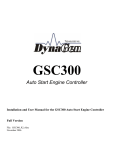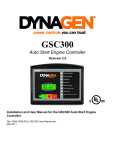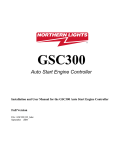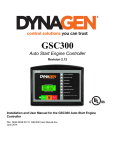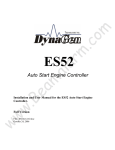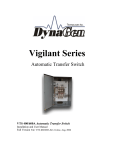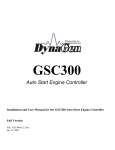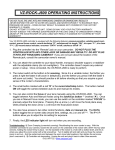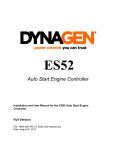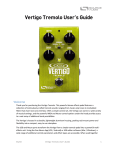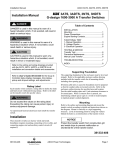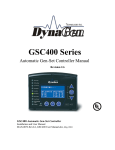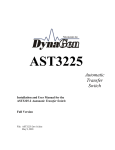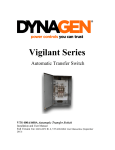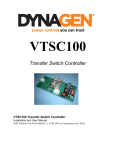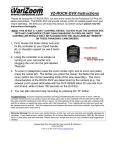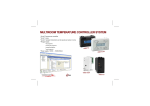Download GSC102 User Manual R2.0
Transcript
GSC102 Auto Start Engine Controller Installation and User Manual for the GSC102 Auto Start Engine Controller Full Version File: GSC102-12_R2.doc November 14, 2006 2 LIMITED WARRANTY POLICY: The Seller warrants articles sold hereunder to be free from defects in material and workmanship. These express warranties are the sole warranties of the Seller and any other warranties, expressed, implied in law, or implied in fact, are hereby specifically excluded. The Seller’s sole obligation under its warranty shall be, at its option, to either issue a credit, or repair or replace any article or part thereof, which is proved to be defective. Any adjustment of credits will be based upon original billing prices. All warranties shall expire 5 years from date of shipment by the Seller, unless otherwise specified in other written communications from the Seller. Any replacement product provided to the Buyer shall be subject to the original warranty period, which will expire 5 years from the date of shipment of the original article. Notice of claimed breach of warranty must be given within the applicable period. No allowances shall be made to the Buyer for any transportation, duties, brokerage fees, labor costs, or parts adjustments or repairs, or any other work, unless said charges are authorized in writing, in advance, by the Seller. The Seller shall, in no event, be liable for special or consequential damages or for loss of profit. The warranty shall not extend to any articles or parts thereof which have been installed, used, or serviced, other than in conformity with the Seller’s application specifications, manuals, bulletins, or instructions, or, if none, shall have been subjected to improper installation, misuse, or neglect. The warranties shall not apply to any materials or parts thereof, furnished by the Buyer, or acquired from others at the Buyer’s request and/or to the Buyer’s specifications or designs. The foregoing limitations on the Seller’s liability in the event of breach of warranty shall also be the absolute limit of the Seller’s liability in the event of the Seller’s negligence in manufacture, installation, service, or otherwise, with regard to the articles covered hereby, and upon the expiration of the stated warranty period, all such liabilities shall terminate. 7. RETURNS: If any article is claimed to be defective in material or workmanship, the Seller, upon notice promptly given, will issue a written return material authorization (RMA) with shipping instructions for return to the Seller. All returns must be accompanied by an RMA number or shipments will not be accepted by the Seller. Articles which are returned as defective, but are found to meet the specifications agreed upon, will be subject to a re-testing charge. At the discretion of the Seller, unused and undamaged Standard Products may, under certain circumstances, be accepted back for credit or exchange. A restocking charge of 15% will apply. Unused custom designed products will not be accepted back for credit or exchange. For questions or comments regarding this product, contact: DynaGen Technologies Inc. Phone (902) 562 0133 Fax: (902) 567 0633 Email: [email protected] WEB SITE: www.dynagen.ca Operating & Installation Manual for the GSC102-12 Engine Controller 3 SPECIFICATIONS Operating VDC Limits: (5.0VDC min.- 16VDC max.) Quiescent Current Draw: 8mA (Auto position) + Battery Current Draw: 1.2mA (Auto position) Operating Current Draw: 140mA at 12VDC Reverse Polarity Protected: Internal protection will prevent damage to unit under a reverse polarity condition. Re-connect power leads properly, and normal operation will resume. Speed Sensing Input Accepts: Generator AC Output Directly Speed Sensing Maximum Rating: Withstands Line Voltage (300 V.A.C.) Operating Temperature Range: -40 O C ⇒ +85 O C Operating Humidity Range: 0 ⇒ 95% Non-condensing Fuel & Crank Contact Output: 1A max., continuous Switch to +battery when energized Annunciation and Fault Outputs: 300mA max. per output, Continuous Switch to +battery when energized Lamp Test Terminal: Switch to + battery to test LED’s Actual Unit Weight: .138 lb Shipping Weight: .148 lb 1 lb complete in packaging carton Unit Dimensions: 4" (W) × 4.75" (L) × 0.75" (D) Shipping Dimensions: 4.5" (W) × 7.6" (L) × 1.25" (D) -Specifications May change without notification Operating & Installation Manual for the GSC102-12 Engine Controller 4 WIRING INSTALLATION GUIDELINES Danger: Never work on the engine while its power is on. This controller does not generate a warning signal prior to automatic engine start. Warning signs should be placed on engine equipment indicating this important safety measure. INSTRUCTIONS Following these instructions will help avoid common installation problems during wiring and setup. • Battery must be disconnected before any wiring connections are made. • Wire length from the engine to the controller should not exceed 6 meters (20 feet). Wiring size and type should be as specified below. Use stranded wire, since solid wire has a tendency to crack, break and loosen over time. TYPES AND SIZES Terminal Wire Size Current max. Function 1 18 100mA +Battery (Main Power connection) 2 18 Not Used 3 18 1A Starter Solenoid / Pilot Relay 4 18 3A Start/Stop Connection 5 18 3A Auto Switch 6 18 300mA General Failure 7 18 100mA Speed Signal Connection 8 18 100mA Speed Signal Connection 9 18 Not Used 10 18 100mA External LED Test Switch (there is an automatic LED test feature on startup) 11 18 3A Battery Ground (-) 12 18 1A Fuel Solenoid / Pilot Relay 13 18 7mA Oil Pressure Switch 14 18 7mA High Temperature Switch 15 18 350mA Common Ground (for annunciation output loads) 16 18 300mA General Failure Output 17 18 300mA Engine Run Output 18 18 300mA Overcrank (failure to start) Output 19 18 300mA Low Oil Pressure Output 20 18 300mA High Engine Temperature Output 21 18 300mA Overspeed Output 22 18 300mA Low Battery Output 23 18 300mA Underspeed Output 24 18 350mA Common Ground (for annunciation output loads) Operating & Installation Manual for the GSC102-12 Engine Controller 5 WIRING GUIDELINES 1. DO NOT use wire smaller than 18 AWG as smaller wire has a tendency to crack and break over time. 2. The connections supplying DC power to the GSC102-12 panel should preferably run directly from the battery posts with no splices or other connections. Avoid, as much as possible, using chassis (aluminum or iron engine parts) as return conductor for battery negative voltage; copper wiring is recommended. Failure to follow the above may result in erratic operation, due to large voltage drops across wiring connections. 3. DO NOT exceed the maximum rated current and voltage on each of the controller outputs. Do not exceed 1A for the Fuel and Crank Outputs. Do not exceed 300mA for the General Fault Output or any annunciation outputs. Do not exceed 500mA for annunciation outputs combined. 4. The fuel and crank outputs do not provide short circuit protection. DO NOT short Crank Output or Fuel Outputs to ground. This will cause damage to the control board. If protection is required for short circuit conditions it is advised to install a Fuse on each of the individual controller outputs to protect the control board. 5. DO NOT use AC coil slave relays from controller outputs. Use intermediate relays of suitable size and coil rating. 6. To verify the operation of engine controller outputs, measure voltage (i.e. meter in volts) when outputs should be ON. 7. There is an internal diode connected between AUTO and Start/Stop terminals. This diode provides the capability of starting and running the engine-generator system when +battery is only supplied to the Start/Stop terminal. This diode is provided for compatibility with AUTO/OFF/TEST switch configuration. If a wiring fault occurs such that +battery is connected to Start/Stop terminal and Battery Ground is connected to AUTO terminal this will cause a short circuit to be applied across the controller terminals and result in damage to control board. We recommend the installation of a fuse on the main +battery connection wired to AUTO/OFF/TEST switch. A 3A fuse is recommended in this line. 8. The Low oil pressure and High engine temperature sensors must be the switch type. In the case of the oil pressure switch it would be open during normal engine run (i.e. oil pressure ok) and close to either ground or +battery on low oil pressure failure, similarly the high engine temperature switch would be open during normal engine conditions and close to ground or +battery on high engine temperature failure. 9. Speed sensing input terminals do not have polarity sensitivity therefore the AC generator output leads can be connected in any polarity configuration to the controller speed sensing terminals. Do not exceed 300VAC on speed sensing input terminals. Operating & Installation Manual for the GSC102-12 Engine Controller 6 Controller terminal connections Term # Description 1 +battery connection to controller module. 2 Not used 3 Crank Output provides 1A maximum. Crank Output closes to +12VDC during cranking, and opens when the engine has started, or during crank rest. 4 (Start/Stop) Terminal. When +12 VDC is applied, the controller proceeds to initiate starting the engine. 5 Auto Terminal. When +12 VDC is applied; the controller is in the standby mode waiting for a Start/Stop signal 6 General Failure. This output is energized when a controller fault condition occur. This terminal switches to +battery when energized. Do not exceed 300mA. 7 Speed 1. Speed signal input for Crank Disconnect, Engine Run, and Overspeed sensing. 300 VAC max. Input voltage. 8 Speed 2. Speed signal input for Crank Disconnect, Engine Run, and Overspeed sensing. 300 VAC max. Input voltage. 9 NOT USED 10 Lamp Test. Connecting +12VDC to lamp test activates all front panel LED’s. (Note: there is Automatic Lamp test provisions on power up which can eliminate the need for external lamp test switch) 11 Main Battery Ground connection for the controller module. A good ground connection, directly from the battery, is required for proper operation. 12 Fuel Output provides 1A maximum. Fuel Output closes to +12 VDC when start signal is initiated, and opens when either an engine failure is detected or when stop signal is applied. 13 Oil Pressure Switch. For proper operation, oil input must be connected to ground or +12VDC via an oil switch. This switch must be the N.O. type, close on failure (low pressure). 14 Temperature Switch. For proper operation, temperature input must be connected to ground or +12VDC via a temperature switch. This switch must be the N.O. type, close on failure (high temperature). 15 Annunciation common ground. Common ground for annunciation outputs only. Do not exceed 500mA combined on all annunciation outputs. 16 General Failure Output. Do not exceed 300mA. 17 Engine Run Output. Do not exceed 300mA. 18 Overcrank Output. Do not exceed 300mA. 19 Low Oil Pressure Output. Do not exceed 300mA. 20 High Engine Temperature Output. Do not exceed 300mA. 21 Overspeed Output. Do not exceed 300mA. 22 Low Battery Output. Do not exceed 300mA. 23 Underspeed Output. Do not exceed 300mA. 24 Annunciation common ground. Common ground for annunciation outputs only. Do not exceed 500mA combined on all annunciation outputs. Operating & Installation Manual for the GSC102-12 Engine Controller 7 Wiring Connection Diagram GSC102-12 Operating & Installation Manual for the GSC102-12 Engine Controller 8 Circuit Board Arrangement GSC102-12 Operating & Installation Manual for the GSC102-12 Engine Controller 9 CONTROLLER OVERVIEW The GSC102-12 is manufactured with the following functions: 1. Controller Settings 2. Failure Conditions 3. Underspeed 4. Not In Auto 5. Low Battery Voltage 6. Low Oil Input 7. High Temperature Input 8. LED Test 9. Speed Signal Sensitivity 10. Time Delay on Engine Start 11. Cool-Down 1: CONTROLLER SETTINGS: The GSC102-12 has the following fixed settings: Crank Disconnect Setting: 20 Hz Overspeed Setting: 69 Hz Crank Tries: 3 Crank/ Rest Settings: 10 seconds crank, 10 seconds rest. NOTE: If the speed of the controller does not go to zero during Crank/Rest, the controller will wait until the speed goes to zero before re-initiating the cranking sequence. 2: FAILURE CONDITIONS: The following conditions can cause the unit to enter a failure condition: Low oil pressure High engine temperature Overcrank (failure to start) Overspeed Underspeed (Indicated by solid RED low oil pressure LED) (Indicated by solid RED high engine temperature LED) (Indicated by solid RED Overcrank LED) (Indicated by solid RED Overspeed LED) (Indicated by solid RED Underspeed LED) The General Fault Output is rated at 300mA maximum. 3: UNDERSPEED: The GSC102-12 is equipped with an Underspeed function. If the speed of the controller falls below 53 Hz for a period of 2.5 seconds, an Underspeed Failure is triggered. The controller will shut down the engine, locking out the engine from further starting. The RED Underspeed LED will be illuminated, and the General Failure Output will be energized. To reset the fault power must be removed from the AUTO terminal and then re-applied. NOTE: Underspeed failure verification is only enabled 30 seconds after the engine has started and GREEN running LED is illuminated. Operating & Installation Manual for the GSC102-12 Engine Controller 10 4: NOT IN AUTO: When there is no power applied to the AUTO terminal (and +12 VDC maintained to the NOT IN AUTO terminal), the RED NOT IN AUTO LED will illuminate. NOTE: + Battery must be permanently connected to the NOT IN AUTO terminal for the NOT IN AUTO condition and LED indication to function properly. 5: LOW BATTERY VOLTAGE: In the event the battery voltage drops below 11 VDC, the engine controller displays a Low Battery condition. The Low Battery Voltage condition can occur when the AUTO/OFF/TEST switch is in the AUTO or START/STOP conditions but not while the unit is in the cranking mode or in failure mode. 6: LOW OIL INPUT: The Low Oil Input Pressure input can close to + Battery or to Ground to initiate a failure. The oil pressure switch must be the type that is NORMALLY open while running, and closes on failure (low oil pressure). Note: Low Oil Pressure monitoring is only enabled 15 seconds after the engine has started and GREEN running LED is illuminated. (Bypass timer period) 7: HIGH TEMPERATURE INPUT: The High Temp Input can close to + Battery or to ground to initiate a failure. The engine temperature switch must be the type that is NORMALLY open while running, and closes on failure (high engine temperature). Note: high engine temperature monitoring is only enabled 15 seconds after the engine has started and GREEN running LED is illuminated. (Bypass timer period) 8: LED TEST: Automatic LED test is provided on power up of the controller unit. When power is applied to AUTO terminal the controller flashes all the front panel indicating LED’s 3 times, allowing the user to verify the functionality of the LED’s. As an alternative an LED test switch can be connected to the controller unit which allows means to turn on all the front panel LED’s. This LED test terminal must be switched to +battery to illuminate all the LED’s. 9: SPEED SIGNAL SENSITIVITY: The controller will accept up to 300 VAC, 60 Hz from Direct Generator Output for speed sensing. The following values are minimal recommended voltages for speed signal sensing: 20 HZ - .075 V (75mV) 60 HZ - .6V (600mV) 10: TIME DELAY ON ENGINE START (T.D.E.S.): The GSC102-12 has a feature which provides a delay before the engine is started, this feature is provided to prevent nuisance starting of the engine generator system during brief power outages. The Engine Run LED will flash during this delay. The “Time Delay on Engine Start” can be enabled by cutting the RED TDES jumper on the GSC102-12. The TDES time delay is fixed at 10 seconds when the jumper is cut. Operating & Installation Manual for the GSC102-12 Engine Controller 11 11: COOL-DOWN: The GSC102-12 has a special feature of a Cool-Down period which allows the engine-generator system to continue to run after the stop signal has been received (Note: power must be applied to AUTO terminal for cool-down timer to function correctly). This feature is provided to allow the engine-generator system to run unloaded for a period of time. The Cool-down timer is fixed at a 2 minute delay. The Cool-Down timer can be disabled by cutting the White Cool-Down jumper on the GSC102-12. With the jumper wire cut, the Cool-Down is disabled and the unit will shut off the engine as soon as the stop signal is received. LED LAYOUT Front View (Component Side of Board) Operating & Installation Manual for the GSC102-12 Engine Controller 12 LED INDICATIONS FRONT PANEL LED INDICATIONS LED Appearance Not in Auto LED is ON. No LED’s ON Steady Low Oil LED Steady High Temperature LED Steady Overcrank LED Steady Overspeed LED Underspeed LED Was Engine Cranking? Was Engine Running? Steady Engine Running LED Flashing Engine Running LED Condition/Failure Unit does not have +12 VDC to Auto terminal, but has +12 VDC to the Not in Auto Terminal. “OFF”, no +12 VDC to “Auto” or “Not in Auto” terminal. Engine Cranking but not running. Low Oil Pressure Failure, check engine oil. Over Temperature Failure, check coolant. Engine would not start after specified Crank tries. Check fuel supply and check starter to confirm it is operating correctly. Speed signal present above Overspeed setting. Check engine governor and verify AC frequency. The speed signal was below 53 HZ while running. The engine has stalled, the speed signal has been lost, or the enginegenerator was overloaded. Engine controller is in running mode of operation. Crank Rest period OR TDES period. WARNING Cranking will resume / begin soon. Operating & Installation Manual for the GSC102-12 Engine Controller 13 TROUBLE SHOOTING TIPS TROUBLE POSSIBLE CAUSE SUGGESTED ACTION Unit does not operate when powered to Test mode Power leads to unit are reversed Confirm correct wiring for ground and (+)battery and re-attempt testing. Run wire directly from battery (-), to the ground terminal (#11on main connector) on controller unit. To verify low battery, wait 10 to 20 seconds and see if Engine Run light flashes indicating Crank Rest. re-charge battery. Measure battery voltage appearing on AUTO position. Clean terminals and re-charge battery Refer to engine control wiring section and check crank connections Run wire directly from battery (-), to the ground terminal (#11on main connector) on controller unit. Check wiring, slave relay, and fuse. re-test controller again. Check fuel level, add fuel if necessary Refer to engine control wiring section and check ignition connections Check fuel relay and replace if damaged. Bad ground connection from engine to controller unit Battery Voltage is too low Engine does not crank Engine cranks but does not start Battery is low or terminals are dirty Crank circuitry wiring improperly connected Bad ground connection from engine to controller Slave relay on crank damaged, or in-line fuse is blown Out of fuel Ignition control wiring not installed properly Fuel relay damaged Engine starts but shuts down after “Oil BypassTM period” due to low oil/high temp Annunciation output not working Oil/Temp input wiring improperly connected. Underspeed failure LED on Speed signal improperly connected, missing, or damaged. Crank output damaged, not working Fault (short or overload) on one of the annunciation outputs Starter or starter solenoid damaged Generator overloaded while running Solid oil LED immediately on start-up, without engine actually cranking or starting. False Speed Signal being detected by controller. This problem can sometimes occur in installations where there is AC power from inverters near generator output lines connected to the speed signal wires. Check wiring for proper connections. Disconnect oil pressure and engine temperature wires and confirm the switches are open during normal engine operation. Check wiring for fault. The annunciation outputs do not provide short circuit therefore there may be damage on control board if short is discovered on annunciation output. Check speed signal wiring; replace damaged speed signal source. Check wiring and replace controller if necessary Replace/repair damaged starter or starter solenoid. Turn off loads and restart generator Install a small step down transformer between the speed sensing wires and the generator output. If the neutral from the generator output is not grounded, attach it to ground Operating & Installation Manual for the GSC102-12 Engine Controller 14 TECHNICAL NOTES ON FREQUENTLY ASKED QUESTIONS 1. Controller Memory Reset Time The engine controller needs time for it’s memory to reset. If one was to turn the power to the controller off and then back on again without waiting a few seconds to clear the memory, an underspeed condition will be indicated because the controller still thinks it is in run mode and sees that the generator has stopped. This would be indicated by a solid underspeed LED. If the controller is left OFF for several seconds before it is put into auto, the memory will be cleared and it will function normally. 2. Step-Down Transformer Use On Speed Sensing Cable With Inverter Systems In some applications engine controllers are used on generators where there is no utility connection and inverters are used to provide AC power instead of a utility. Inverters can produce harmonics that can cause small AC signals to appear on wires that are near any power lines being fed by the inverter. If the generator output wires are located close to a line being powered by an inverter, a small AC signal can appear on the generator output lines when the inverter is on. This can fool the engine controller into thinking that the engine-generator systems is running if the speed sensing wires are connected to the generator output lines. This small AC signal can cause the controller to appear to have a Low Oil Failure when the remote start contacts are closed or the controller is put in the manual/test mode. The controller may think the generator is already running and immediately check to make sure there is oil pressure. Since the engine really hasn’t started yet, there is no oil pressure and the controller sees a low oil fault. This is seen as the Oil LED turning on solid even before the engine starts to engage the starter. Without this false speed signal the controller will not look for oil pressure until 15 seconds after the engine has started to run and the crank disengages. The false speed signal can be eliminated by installing a small transformer between the generator output and the speed sensing terminals of the controller. This transformer should be rated for 120 or 240 volts on the input or primary coil (depending on the generator output voltage you are using for speed sensing), and have an output voltage of around 12VAC on the secondary of the transformer. The two wires from the secondary of the transformer are connected to the two wires of the speed sensing terminals on the GSC102-12 controller. The stepdown transformer acts to reduce the false speed signal on the line to a level that the engine controller will not recognize as the engine running. A common size transformer that would serve this purpose would be 24VA. Operating & Installation Manual for the GSC102-12 Engine Controller














